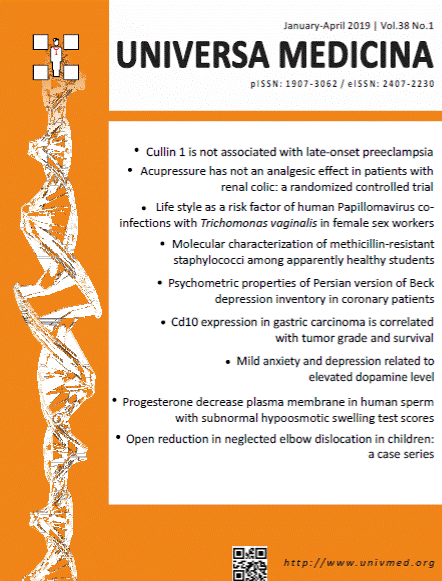Mild anxiety and depression related to elevated dopamine level
Main Article Content
Abstract
Dopamine is an important neurotransmitter that plays a role in the pathogenesis of anxiety and depression. Dopamine secretion occurs when there is a pleasurable stimulus. Blood dopamine levels have the potential to be developed as biomarkers of depression or anxiety, but previous studies related to the relationship between dopamine levels and levels of anxiety and depression are still controversial. The purpose of this study was to determine the correlation between anxiety and depression score with dopamine level in young adults.
Methods
This was an observational cross sectional study. A total of 43 subjects aged 18 to 40 years were recruited by consecutive non-random sampling according to inclusion and exclusion criteria. Anxiety and depression were assessed using the Beck anxiety inventory and Beck depression inventory-II questionnaire. Dopamine plasma level was measured using the enzyme-linked immunosorbent assay (ELISA). The Spearman rho correlation test was used to analyze the data and p<0.05 was considered significant.
Results
The median dopamine levels in respondents with mild, moderate and severe anxiety were respectively: 77.79; 63.43; 62.51 ng/mL (p=0.043). The median dopamine levels in respondents with reasonable depression, mood disorder, moderate and severe depression were respectively: 79.2; 61,32; 62,51; 60.24 (p=0.001). Correlation test results showed a weak correlation between dopamine and anxiety (r=- 0.310) and a moderate correlation for depression (r=-0.505).
Conclusion
Mild anxiety and depression were associated with elevated dopamine level in young adults. Further studies are required to confirm the role of dopamine metabolism in anxiety and depression in young adults.
Article Details
Issue
Section

This work is licensed under a Creative Commons Attribution-NonCommercial-ShareAlike 4.0 International License.
The journal allows the authors to hold the copyright without restrictions and allow the authors to retain publishing rights without restrictions.
How to Cite
References
World Health Organization. Depression and other common mental disorders: global health estimates. Geneva: World Health Organization; 2017.
Badan Penelitian dan Pengembangan Kesehatan Kementerian Kesehatan RI. Riset Kesehatan Dasar 2013. Jakarta : Badan Penelitian dan Pengembangan Kesehatan Kementerian Kesehatan RI;2013.
Maina G, Mauri M, Rossi A. Anxiety and depression. J Psychopathol 2016;22:236–50.
Eskow JKL, George JA, Bishop C. L-DOPA-induced dysregulation of extrastriatal dopamine and serotonin and affective symptoms in a bilateral rat model of Parkinson’s disease. Neuroscience 2012;;218:243–56.
Katie M. Smitha KM, Renshawb PF, Bilello J. The diagnosis of depression: current and emerging methods. Compr Psychiatry 2013; 54: 1–6. doi:10.1016/j.comppsych.2012.06.006.
Pan JX, Xia JJ, Deng FL, et al. Diagnosis of major depressive disorder based on changes in multiple plasma neurotransmitters: a targeted metabolomics study. Transl Psychiatry 2018;8:1–10. d : 10.1038/s41398-018-0183-x
Lai CY, Yu SL, Hsieh MH, et al. MicroRNA Expression aberration as potential peripheral blood biomarkers for schizophrenia. PLoS One 2011;6:e21635. doi: 10.1371/journal.pone.0021635.
Bocchio Chiavetto L, Maffioletti E, Bettinsoli P, et al. Blood microRNA changes in depressed patients during antidepressant treatment. Eur Neuropsychopharmacol 2013;23:602–11. doi :10.1016/j.euroneuro.2012.06.013.
Bonapersona V, Joëls M, Sarabdjitsingh RA. Effects of early life stress on biochemical indicators of the dopaminergic system: a 3 level meta-analysis of rodent studies. Neurosci Biobehav Rev 2018;95:1–16. doi :10.1016/j.neubiorev.2018.09.003.
Hori H, Kunugi H. Dopamine agonist-responsive depression. Psychogeriatrics. 2013;13:189–95.
Bonomaully M, Khong T, Fotriadou M, Tully J. Anxiety and depression related to elevated dopamine in a patient with multiple mediastinal paragangliomas. Gen Hosp Psychiatry 2014 ;36:449.e7-e8.
Robinson HM, Hood SD, Bell CJ, Nutt DJ. Dopamine and social anxiety disorder. Rev Bras Psiquiatr 2006;28:263–4.
Belujon P, Grace AA. Dopamine system dysregulation in major depressive disorders. Int J Neuropsychopharmacol 2017;20:1036–46.
Tavakoli R, Nouri A, Masoudi R, Mirhoseini M, Ahmadpour F, Masoudi R. Serum markers related to depression: a systematic review. J Med Biomed Sci 2017;6:30–42. doi :10.4314/jmbs.v6i3.5.
Meng G, Ma X, Li L, et al. Predictors of early-onset post-ischemic stroke depression: a cross-sectional study. BMC Neurol 2017;17:1–8.
Luo Y, Zheng L, Zhou J, Pi P. Relationship between the levels of estradiol and monoamine neurotransmitters and postpartum depression. Zhonghua Fu Chan Ke Za Zhi 2018;42:745–8.
Zhang HX, Jiang WQ, Lin ZG, Du YS, Vance A. Comparison of psychological symptoms and serum levels of neurotransmitters in Shanghai adolescents with and without internet addiction disorder: a case-control study. PLoS One 2013;8:8–11.
Muntingh ADT, Van Der Feltz CM, Van Marwijk HWJ, Spinhoven P, Penninx BWJH, Van Balkom AJLM. Is the Beck anxiety inventory a good tool to assess the severity of anxiety? A primary care study in the Netherlands study of depression and anxiety (NESDA). BMC Fam Pract 2011;12:66.
Sorayah. Uji validitas konstruk Beck depression inventory II (BDI-II). J Pengukuran Psikol Pendidik Indones 2015;IV:29–44.
Zavos P. Women with anxiety and depression: out of the darkness and into the light. Women’s Heal 2017;4:167–70.
Manikkoth S, B D, Sequeira M, Elizabeth Joy A, Rodrigues R. Assessment of brain dopamine levels to evaluate the role of tylophora indicaethanolic extract on alcohol induced anxiety in Wistar albino rats. J Young Pharm 2016;8:91–5.
Riva J, Bondiolotti G, Michelazzi M, Verga M, Carenzi C. Anxiety related behavioural disorders and neurotransmitters in dogs. Appl Anim Behav Sci 2008;114:168–81.
Ayano G. Dopamine: receptors, functions, synthesis, pathways, locations and mental disorders: review of literatures. J Ment Disord Treat 2016;2:2–5.
Rubí B, Maechler P. Minireview: new roles for peripheral dopamine on metabolic control and tumor growth: let’s seek the balance. Endocrinology 2010;151:5570–81.
Picillo M, Santangelo G, Erro R, et al. Association between dopaminergic dysfunction and anxiety in de novo Parkinson’s disease. Park Relat Disord 2017;37:106–10.
Nasehi M, Piri M, Nouri M, Farzin D, Nayer-Nouri T, Zarrindast MR. Involvement of dopamine D1/D2 receptors on harmane-induced amnesia in the step-down passive avoidance test. Eur J Pharmacol 2010 ;634:77–83.
Suominen T, Piepponen TP, Kostiainen R. Permeation of dopamine sulfate through the blood-brain barrier. PLoS One 2015;10:e0133904.
Ambade V, Arora MM, Singh P, Somani BL, Basannar D. Adrenaline, noradrenaline and dopamine level estimation in depression: does it help? Med J Armed Forces India 2009;65:216–20. doi :10.1016/S0377-1237(09)80006-3.
Fidalgo T, Morales-Quezada L, Muzy G, et al. Biological markers in non-invasive brain stimulation trials in major depressive disorder: a systematic review. J Ect 2015;30:47–61. doi: 10.1097/YCT.0b013e31828b34d8.


